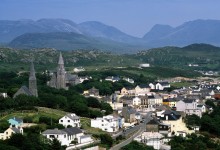The earliest written records of Ireland come from classical Greco-Roman geographers. Ptolemy in his Almagest refers to Ireland asMikra Brettania (Little Britain), in contrast to the larger island, which he called Megale Brettania (Great Britain).[19] In his later work,Geography, Ptolemy refers to Ireland as Iouernia and to Great Britain as Albion. These “new” names were likely to have been the Celtic names for the islands at the time. The earlier names, in contrast, were likely to have been coined before direct contact with local peoples was made.
The Romans would later refer to Ireland by this name too in its Latinised form, Hibernia, or Scotia. Ptolemy records sixteen nations inhabiting every part of Ireland in 100 AD.[23] The relationship between the Roman Empire and the tribes of ancient Ireland is unclear. However, a number of finds of Roman coins have been made, for example at Newgrange.

Irish culture has had a significant influence on other cultures, especially in the fields of literature and, to a lesser degree, science and education. Alongside mainstream Western culture, a strong indigenous culture exists, as expressed for example through Gaelic games, Irish music, and the Irish language
The Bronze Age – defined by the use of metal – began around 2,500 BC, with technology changing people’s everyday lives during this period through innovations such as the wheel, harnessing oxen, weaving textiles, brewing alcohol, and skillful metalworking, which produced new weapons and tools, along with fine gold decoration and jewellery, such as brooches and torcs.